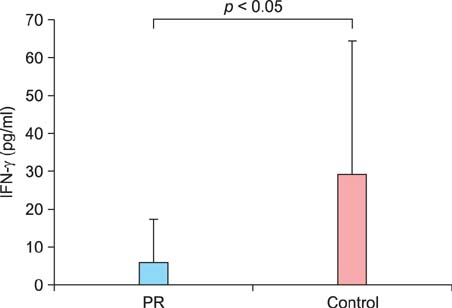Ann Dermatol.
2014 Aug;26(4):522-523. 10.5021/ad.2014.26.4.522.
Decreased Serum Level of Interferon-gamma in Patients with Pityriasis Rosea
- Affiliations
-
- 1Department of Dermatology, No. 1 Hospital, Anhui Medical University, Hefei, China. wpg2370@163.com
- 2Department of Clinical Laboratory, No. 1 Hospital, Anhui Medical University, Hefei, China.
- KMID: 2265599
- DOI: http://doi.org/10.5021/ad.2014.26.4.522
Abstract
- No abstract available.
Figure
Reference
-
1. Rebora A, Drago F, Broccolo F. Pityriasis rosea and herpesviruses: facts and controversies. Clin Dermatol. 2010; 28:497–501.
Article2. Neoh CY, Tan AW, Mohamed K, Sun YJ, Tan SH. Characterization of the inflammatory cell infiltrate in herald patches and fully developed eruptions of pityriasis rosea. Clin Exp Dermatol. 2010; 35:300–304.
Article3. Rajpara SN, Ormerod AD, Gallaway L. Adalimumab-induced pityriasis rosea. J Eur Acad Dermatol Venereol. 2007; 21:1294–1296.
Article4. Nastke MD, Becerra A, Yin L, Dominguez-Amorocho O, Gibson L, Stern LJ, et al. Human CD4+ T cell response to human herpesvirus 6. J Virol. 2012; 86:4776–4792.5. Gangemi S, Minciullo PL, Guarneri F, Cristani M, Arcoraci T, Spatari G, et al. Increased serum levels of interleukin-22 in patients affected by pityriasis rosea. J Eur Acad Dermatol Venereol. 2009; 23:858–859.
Article6. Gangemi S, Cannavò SP, Guarneri F, Merendino RA, Sturniolo GC, Minciullo PL, et al. The CX3C-chemokine fractalkine (CX3CL1) is detectable in serum of patients affected by active pityriasis rosea. J Eur Acad Dermatol Venereol. 2006; 20:1366–1367.
Article7. Qiu Y, Huang Y, Chen J, Qiao D, Zeng G, Cai J. Depletion of IL-22 during culture enhanced antigen-driven IFN-γ production by CD4(+)T cells from patients with active TB. Immunol Lett. 2013; 150:48–53.
Article
- Full Text Links
- Actions
-
Cited
- CITED
-
- Close
- Share
- Similar articles
-
- Comments to "A Case of Pityriasis Rosea Associated with Leuprolide Acetate"
- Effect of UVB Phototherapy on Pruritus of Pityriasis Rosea
- A Case of Pityriasis Rosea Associated with Leuprolide Acetate
- Atypical Pityriasis Rosea with Palmoplantar Involvement
- Clinical and Histologic Features of Pityriasis Rosea and Pityriasis Lichenoides in Children


